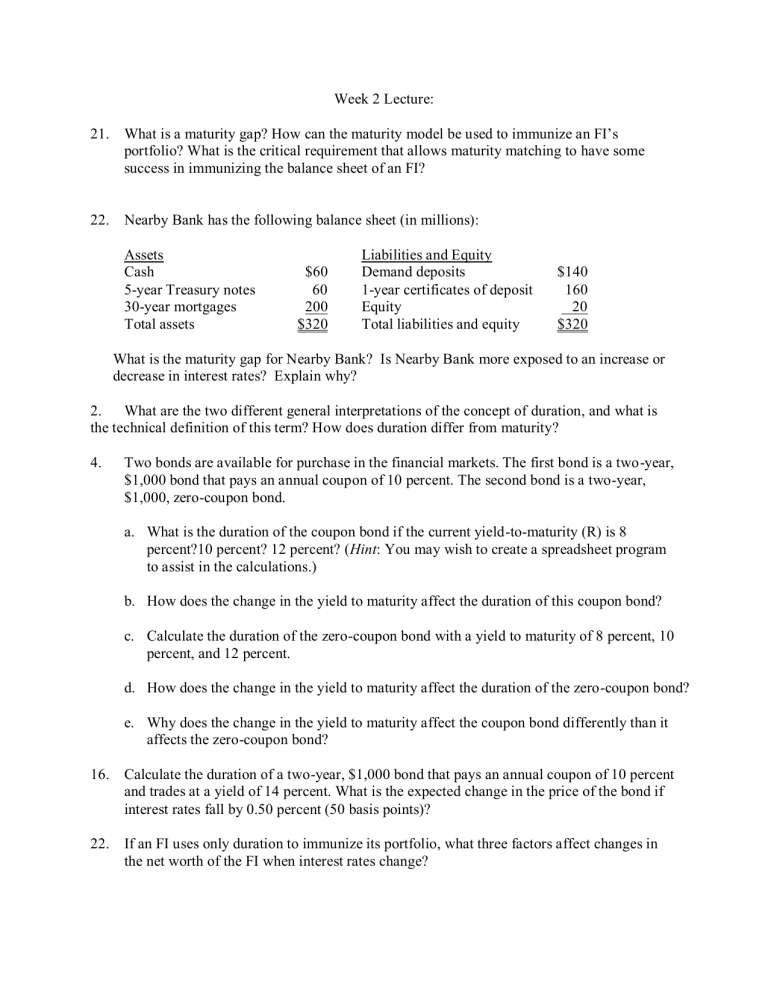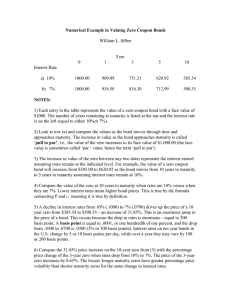
Week 2 Lecture: 21. What is a maturity gap? How can the maturity model be used to immunize an FI’s portfolio? What is the critical requirement that allows maturity matching to have some success in immunizing the balance sheet of an FI? 22. Nearby Bank has the following balance sheet (in millions): Assets Cash 5-year Treasury notes 30-year mortgages Total assets $60 60 200 $320 Liabilities and Equity Demand deposits 1-year certificates of deposit Equity Total liabilities and equity $140 160 20 $320 What is the maturity gap for Nearby Bank? Is Nearby Bank more exposed to an increase or decrease in interest rates? Explain why? 2. What are the two different general interpretations of the concept of duration, and what is the technical definition of this term? How does duration differ from maturity? 4. Two bonds are available for purchase in the financial markets. The first bond is a two-year, $1,000 bond that pays an annual coupon of 10 percent. The second bond is a two-year, $1,000, zero-coupon bond. a. What is the duration of the coupon bond if the current yield-to-maturity (R) is 8 percent?10 percent? 12 percent? (Hint: You may wish to create a spreadsheet program to assist in the calculations.) b. How does the change in the yield to maturity affect the duration of this coupon bond? c. Calculate the duration of the zero-coupon bond with a yield to maturity of 8 percent, 10 percent, and 12 percent. d. How does the change in the yield to maturity affect the duration of the zero-coupon bond? e. Why does the change in the yield to maturity affect the coupon bond differently than it affects the zero-coupon bond? 16. Calculate the duration of a two-year, $1,000 bond that pays an annual coupon of 10 percent and trades at a yield of 14 percent. What is the expected change in the price of the bond if interest rates fall by 0.50 percent (50 basis points)? 22. If an FI uses only duration to immunize its portfolio, what three factors affect changes in the net worth of the FI when interest rates change? 24. The balance sheet for Gotbucks Bank, Inc. (GBI), is presented below ($ millions): Assets Liabilities and Equity Cash $30 Core deposits $20 Federal funds 20 Federal funds 50 Loans (floating) 105 Euro CDs 130 Loans (fixed) 65 Equity 20 Total assets $220 Total liabilities & equity $220 Notes to the balance sheet: The fed funds rate is 8.5 percent, the floating loan rate is LIBOR + 4 percent, and currently LIBOR is 11 percent. Fixed rate loans have five-year maturities, are priced at par, and pay 12 percent annual interest. The principal is repaid at maturity. Core deposits are fixed rate for two years at 8 percent paid annually. The principal is repaid at maturity. Euro CDs currently yield 9 percent. a. b. c. d. e. f. g. h. What is the duration of the fixed-rate loan portfolio of Gotbucks Bank? If the duration of the floating-rate loans and fed funds is 0.36 year, what is the duration of GBI’s assets? What is the duration of the core deposits if they are priced at par? If the duration of the Euro CDs and fed funds liabilities is 0.401 year, what is the duration of GBI’s liabilities? What is GBI’s duration gap? What is its interest rate risk exposure? What is the impact on the market value of equity if the relative change in all interest rates is an increase of 1 percent (100 basis points)? Note that the relative change in interest rates is R/(1+R) = 0.01. What is the impact on the market value of equity if the relative change in all interest rates is a decrease of 0.5 percent (-50 basis points)? What variables are available to GBI to immunize the bank? How much would each variable need to change to get DGAP equal to zero? 9. Consider the following balance sheet for MMC Bancorp (in millions of dollars): Calculate the value of MMC’s rate-sensitive assets, rate sensitive liabilities, and repricing gap over the next year. 16. Use the following information about a hypothetical government security dealer named M. P. Jorgan. Market yields are in parenthesis, and amounts are in millions. What is the repricing gap if the planning period is 30 days? 3 months? 2 years? What is the impact over the next 30 days on net interest income if interest rates increase 50 basis points? Decrease 75 basis points? The following one-year runoffs are expected: $10 million for two-year T-notes and $20 million for eight-year T-notes. What is the one-year repricing gap?





